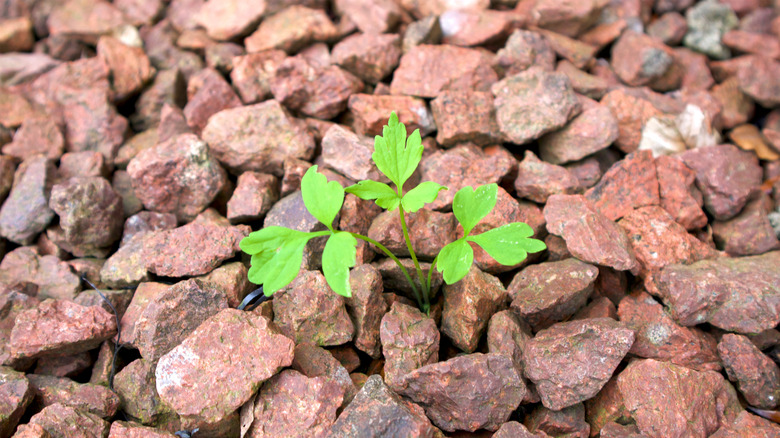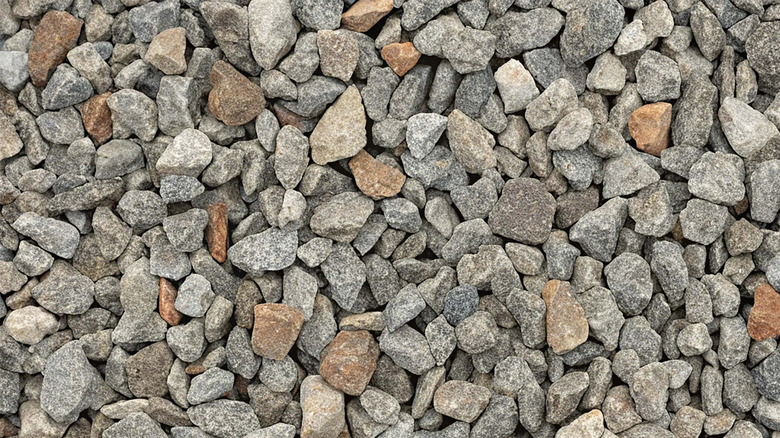The Easiest Way To Stop Weeds From Growing In Gravel Before They Start
Removing weeds from your gravel driveway can feel like a losing battle. Even after pulling them or treating them with chemicals, they often return, especially in driveways, garden paths, and other high-traffic areas alongside grassy spaces. The best way to deal with this problem is to prevent it from starting. Choosing the right kind of gravel can drastically reduce weed growth from the beginning, saving you time and effort later.
Most people focus on surface-level solutions, such as pulling weeds or applying herbicides, but these only treat the symptoms, not the underlying cause. Fabric barriers and chemical treatments can both be practical, but they work best when used as part of a comprehensive strategy. What is often overlooked is the significant contribution of the type of gravel to weed prevention. By combining landscape fabric with angular gravel that naturally locks together, you can create a more compacted, stable surface that weeds struggle to penetrate. This approach is beneficial in areas that are difficult to maintain manually, such as long driveways or decorative paths. A thoughtful gravel setup from the beginning offers a longer-lasting, lower-maintenance fix that keeps your outdoor space looking clean and tidy.
Why angular gravel prevents weeds better than rounded stone
When it comes to keeping weeds from sprouting in your gravel, the shape of the stone plays a bigger role than most people realize. There are different types of gravel to consider when planning your driveway project. Angular gravel consists of stones with jagged, irregular edges naturally interlock to form a dense, compacted surface. This tighter fit limits the air gaps and exposed soil where weed seeds could settle. Without those soft pockets, it's much harder for weeds to take hold.
Crushed stone and decomposed granite are two common types of angular gravel that work exceptionally well for weed control. This kind of gravel not only blocks weed growth but also creates a more stable and durable surface for driveways and paths.
In contrast, smooth, rounded gravel may look decorative, but it shifts more easily and doesn't lock together. This creates space between stones where dirt and rainwater accumulate, providing ideal conditions for the germination of weed seeds. Even with a weed barrier below, those upper-layer gaps can quickly fill with sprouting weeds.
Using rounded gravel often means more maintenance down the line. That includes more weeding, more sweeping, and possibly even reapplying herbicides. Choosing angular gravel from the start gives you a weed-fighting advantage that lasts, reducing the amount of upkeep your outdoor spaces will require.
Layering techniques add even more weed protection
While choosing angular gravel is the most crucial step in preventing weeds, layering materials beneath the surface can make your setup nearly weed-proof. A solid foundation begins with a compacted base layer, often composed of crushed stone or quarry process (QP), which provides stability and facilitates drainage. Additionally, many homeowners install high-quality landscape fabric to block light and prevent weeds from growing through the gravel.
But the key is how these layers work together. When you top the fabric with your base layer and then with 4 to 6 inches of gravel, the compact structure presses the fabric in place, minimizing shifting and further reducing space for weed seeds to germinate. Using a layered approach, especially with materials that naturally resist movement and erosion, can extend the life of your gravel surface while reducing maintenance.
This method is particularly effective in driveways or garden paths where heavy traffic would usually disturb the surface. It also helps maintain the clean look of your space with less maintenance. Though layering takes a bit more effort during installation, it pays off in fewer weeds and a more durable, longer-lasting result.


